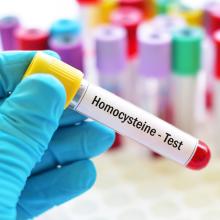What is Homocysteine?

Perhaps you’ve heard of homocysteine. It’s an amino acid and inflammatory marker and if you’ve suffered from autoimmunity or other diseases associated with inflammation (what diseases aren’t associated with inflammation??), then perhaps you’ve seen this value on your own lab work.
Generally, it’s good to get at least 2-3 inflammatory markers tested, including not only homocysteine, but also SED rate (sedimentation rate), EOS (eosinophils), and/or CRP (C-reactive protein).
Today’s post is about how elevated homocysteine is an important contributor to Alzheimer’s disease. Additionally, it’s a factor in cardiovascular disease, stroke, and even some cancers.
It sounds like having an optimal homocysteine level is a good idea.
So, what does homocysteine measure and how is it related to Alzheimer’s?
Let’s review…
Alzheimer’s occurs when the synapse-making signals (the point at which a nervous impulse passes from one nerve/brain cell to another) are outnumbered by the synapse-remodeling/destroying ones.
There are 3 causes of synapse loss:
- Inflammation
- Loss of synapse supporting factors
- Toxins
Homocysteine is a marker of both the first and second factors listed above, but it can also increase when nutritional support is suboptimal.
Homocysteine comes from eating foods with the amino acid methionine. Nuts, beef, lamb, cheese, turkey, pork, fish, shellfish, soy, eggs, dairy, and beans all contain methionine.
But wait…aren’t those foods healthful unless you have a specific allergy to them?
Let’s look deeper.
Methionine is converted into homocysteine, which is converted back into methionine or cysteine, also an amino acid. This conversion requires Vitamins B12, B6, B9 (folate), and the amino acid, betaine.
(Vitamin B12 is often part of a functional thyroid panel—and low B12 can be a tip-off to elevated homocysteine/high inflammation.)
You’ll have no difficulty cycling your homocysteine if you have healthy levels of these B vitamins. But many don’t, which allows homocysteine to build up, often damaging the blood vessels and the brain.
The functional medicine community also says any level of homocysteine above 6 micromoles per liter poses a risk to our health. The higher the homocysteine, the higher the risk.
Not everyone with high levels of homocysteine will develop Alzheimer’s, but high levels are a potentially important contributor to cognitive decline. Specifically, a high level of homocysteine is associated with shrinkage of the hippocampus.
Short-term memory is converted into long-term memory in the hippocampus and research shows the hippocampus is the earliest to degenerate in Alzheimer’s disease and dementia.
Can’t remember what you had for breakfast?
Lose your train of thought in the middle of a sentence?
Have difficulty finding the right word although it feels like it’s on the tip of your tongue?
It could be your hippocampus.
I repeat…it sounds like having an optimal homocysteine level is a good idea.
Your doctor’s office can order the blood test. Conventional medicine test ranges and functional medicine ranges frequently differ. Remember, the functional medicine community says that the optimal range for homocysteine is 6 or under.
If your homocysteine is over 6 micromoles per liter, then what?
Many foods contain the recommended B vitamins and betaine. Normally, “food first” is my recommendation. However Dr. Dale Bredesen recommends a low carb, low starch, vegetable-heavy, gluten-free, dairy-free, smaller-portion-of-meat diet. Many of the foods rich in B vitamins do not fall in this category.
If you’re unable to lower your homocysteine through diet alone, supplementation may be necessary. If you determine supplementation is needed, B vitamins are widely available through Healthful Elements’ Fullscript online dispensary and other quality sources. (You can create a Fullscript account here and we love MegaFood’s Balanced B Complex.)
A few years ago, my homocysteine was over 11. Dietary changes and supplementation reduced my levels to below 7, where they should be. And remembering what I had for breakfast is no longer an issue.
Comments
I have been fighting high
I have been fighting high homocysteins for 2 years. I have gotten it down from a 22 to a 14. But it won’t budge past that. I take a b-12 shot once a week and take homocysteine supplements daily. I have done almost everything to get it down. My doctor thinks it’s the MTFR gene. Any suggestions?
Hi Amy,
Hi Amy,
I will share what Dr. Dale Bredesen recommends in his book The End of Alzheimer’s. This is taken directly from his book: (as always, please talk with your doctor about this protocol and the concern of MTHFR)
Dr. Bredesen recommends activated forms of the suggested vitamins if you have a biochemical makeup that makes it difficult for you to convert the vitamins you take into the active form that your body can use. Possibly MTHFR is at play if you are not able to receive benefit from your supplements.
If homocysteine is above 6 start by taking the following:
pyridoxal-5-phosphate (P5P) form of vitamin B6 / 20-50 mg each day
methylcobalamin (methyl-b12) and adenosylcobalamin forms of B12, 1mg in total each day
methyltetrahydrofolate (methyl-folate) starting with 0.8 mg (and as high as 5 mg) each day
After 3 months recheck homocysteine.
If not reduced to 6 micromoles per liter or lower simply add 500 mg daily of glycine betaine (also called trimethylglycine, available in capsule form).
After 3 months recheck homocysteine.
If it is still too high, reduce methionine in your diet by limiting consumption of foods such as nuts, beef, lamb, cheese, turkey, pork, fish, shellfish, soy, eggs, dairy, and beans.
You may have already tried this approach. This is a general recommendation that should be discussed with your practitioner to see if it suites your health challenges.
Add comment